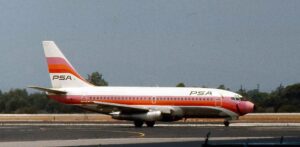One of the early reactions at this point to the collision at DCA this evening was a comparison to earlier similar situations. Now, because of various safety improvements, two planes hitting each other, outside of runway incursions, has become much rarer.
This evening’s flight was operated by PSA Airlines. The current PSA, which operated the American Eagle 5342 involved in the January 29,20225 mid-air crash, was named after Pacific Southwest Airlines, but is not the same airline.
 On September 25, 1978, Pacific Southwest Airlines 182, operated by a Boeing 727, collided mid-air with a Cessna 172. None of the contributors to Flight Wisdom are licensed pilots, so the comparison is on the circumstances. The PSA was alerted to the presence of the Cessna, and was ordered to maintain a visual separation. The PSA Boeing 727 lost visual contact with the Cessna, and due to some static on the radio, the air traffic controller misheard and believed they still had it in sight.The PSA overtook the Cessna, and resulted in the fatal crash of both aircraft.
On September 25, 1978, Pacific Southwest Airlines 182, operated by a Boeing 727, collided mid-air with a Cessna 172. None of the contributors to Flight Wisdom are licensed pilots, so the comparison is on the circumstances. The PSA was alerted to the presence of the Cessna, and was ordered to maintain a visual separation. The PSA Boeing 727 lost visual contact with the Cessna, and due to some static on the radio, the air traffic controller misheard and believed they still had it in sight.The PSA overtook the Cessna, and resulted in the fatal crash of both aircraft.
The accident led to a implementation of a terminal radar service area at San Diego and a review of similar procedures. Service areas, as well as more modern alternatives, are restricted areas of airspace. While there are different restrictive levels today, these restricted areas of airspace impose additional requirements on aircraft flying into busy areas. Aircraft also began to install the TCAS system in response to incidents like this. TCAS, the Traffic Collision Avoidance System, alerts pilots to other aircraft in their vicinity and instructs them to climb or descend to avoid traffic. Despite TCAS, there have still been incidents even with planes that were equipped with it, but usually when the crew ignored the instructions, or obeyed Air Traffic Control over TCAS.
Tonight, according to informal reports from those monitoring Air Traffic Control, PAT25, the Sikorsky Helicopter, was cleared for visual separation from the plane approximately 1.5min before the incident. They were instructed to fly behind the plane. PAT25 advised they had the plane in sight and was again cleared for visual separation, and were cleared about 13 seconds before the collision. That puts responsibility for maintaining distance to the helicopter, as the plane had the right of way. TCAS is limited below 1000 feet, where this occurred, to advisories.
The truth is, US ATC is stretched thin, the area around National Airport is extremely crowded, and the likely explanation in most aviation accidents is human error.